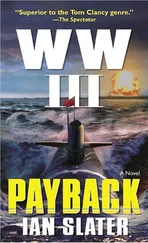Despite the hours off watch that he had devoted sitting listening to the Roosevelt’s “library”—tapes of enemy noise signatures and the types of sea noise — to fine-tune his ability to distinguish between background sea clutter and heavy concentrations of Arctic phytoplankton, Emerson still felt uneasy about this, his first long war patrol in the high Arctic.
While the rest of the crew actually felt safer below the roof of frozen sea, the constant grinding of the pack ice was particularly disconcerting for a sonar operator, the noise having a tendency to “bully” out all other sounds — a fact that Soviet subs had taken advantage of, using their big cargo ships’ prop noise to drown out that of their subs as they broke out of their home ports just before war had officially broken out.
Adding to Emerson’s apprehension was Roosevelt’s mission to remain as an undetected submarine launch platform for the forty-two warheads atop the six Trident missiles—”the weapons of last resort.” Roosevelt’s greatest defense, its silence, meant eschewing its active sonar, whose outgoing noise pulses would give its position away as well as pinpointing the enemy’s.
This meant that unless Emerson received a specific release order from either Captain Brentwood or the officer of the deck to go “active,” all he could do was to stay in the passive mode. However, in passive there was no time/space ratio during the duration between an active sonar’s pulse and the return of its echo.
In short, it would be impossible for him to tell accurately how far away a noise source was, or in any ice-free zone, whether it was on the surface or submerged.
Experienced sub hands often made fairly accurate guesstimates of the distance, but this was based purely on experience, not formula. The fact that survival at sea was as much art as science had been brought home to Emerson during the Russian cruiser attacks against the American subs early in the war. Captain Brentwood’s advice to a colleague had once saved that man’s sub and his crew when, acting quickly in an evasive maneuver, he had simultaneously ordered that the bodies of two men who had died due to flooding caused by a previous depth charge attack be cut up and blown to the surface in several of the torpedo tubes along with diesel oil and assorted garbage, convincing the Russian sub chaser that they’d done their job.
Emerson’s sense of responsibility, the knowledge that he could mistake a “biological” noise, such as the sudden turn of a tightly bunched school of fish, for an attacking sub, weighed heavily on him. It would mean life or death for the entire crew, for if he didn’t identify an enemy sub quickly enough, there’d be no time for Brentwood to get a fish off. And yet if he mistakenly identified a noise as a sub when it wasn’t and Brentwood fired, then at that very moment of the torpedo’s release, any enemy sub listening would hear the high-pressure ejection and the cavitation of the torpedo’s propeller and would know exactly where the Roosevelt was.
The responsibility on Emerson was made worse by the crew’s well-intentioned assurances to him that now they were under the ice, he wouldn’t have to worry about CVs — surface vessels. Oh no? Emerson thought — what if he heard a sudden crackling noise? Would it be the sound of a Soviet sub “ice-picking” through the twelve-foot-thick ice cap to fire a cruise missile? Or would it be simply the ice pressure sounding off as great bergs, calved off one section of the ice pack, came up against another ice sheet? If you got too close to the sound layer, next thing you might hear could be a “triple”: three enemy torpedoes vectoring you even as you dived.
Emerson devoutly wished they were back in the good old plain dangerous North Atlantic and not up here in the depths of the Greenland Sea.
To make matters worse, Emerson could hear a crew member, a new planesman, being reminded by one of the chiefs that beneath the sea, sound traveled in excess of 3,000 miles per hour, compared to the mere 760 miles per hour in air, the sound in the seas racing through the more tightly bunched molecules of water.
But now at least the Roosevelt was traveling at ten miles per hour, and quietly — courtesy of her anechoic sound-absorbing paint and her antivibration quotient engines. Furthermore, Emerson took some comfort in knowing that because of the slow speed, it would be more difficult for the enemy to pick up even the noise of her pumps, which had to be kept on constantly in order to cool the sub’s nuclear reactor, which provided not only the superheated steam for generators to drive the prop, but power for everything else aboard the sub.
It was at that moment, two hours into the dogwatch, that Emerson, while watching normal “pop bottle fizz,” electronic panicles jumping in uniform sine waves on his sonar computer, heard the sound of what he thought must be massive schools of shrimp “clacking,” bearing one six three degrees.
From the size of the blip and the direction, he guessed it was about ten miles from Molloy Deep, and worked back the vectors. It was also at this moment that Able Seaman Arthur G. Leach, a steward, was changing the bed linen on the executive officer’s bunk in the relatively tiny stateroom. Seeing a Walkman on the bed, he bent over, picked it up, and for a moment, seeing no one was around, slipped on the earphones and pressed the button — some old pop singer called Buddy Holly was singing a peppy song called “Peggy Sue.” Leach hadn’t heard the song before, but it had a nice, peppy beat to it, ‘bout some guy head over heels in love. Kinda mushy but catchy, reminding him of his high school dates.
After finishing the linen change, emptying the wastepaper basket, and putting the Walkman back on the captain’s bed, Leach headed down toward the galley for a coffee break. He walked behind the serving counter, took a mug out of its anti-roll hole, and lifted the three-quarter-full Silex pot of coffee out of its antiroll cradle.
Then it happened.
Whether the thing that started it was Leach still moving to the beat of the song he’d just heard, or, as he was to claim later, there’d been an alteration made in the trim of the ship which had caused the ship to yaw slightly, the fact was it happened. Some said it was a spot of butter on the galley’s decking that had probably caused him to lose his footing.
Other than Leach, the first to hear, or rather to “see,” it was Emerson in the blue glow of the sonar room one deck above. Suddenly he saw the steady hiccuping of “ice grind” and shrimp clacking interrupted by a burp: a rounded sine wave on the trace at zero seconds — which told him immediately that it had come from within the sub. He pressed the button for officer of the deck in Control.
“Zeldman, OOD.” Emerson could tell from Zeldman’s relaxed tone that they hadn’t heard it in Control, but even now he knew that the low-frequency thud in the one-hundred- to six-hundred-hertz range was radiating out from the hull at over three thousand miles per hour.
“What have you got?” asked Zeldman easily.
“Noise short, sir. From the sub.”
“Christ! How long?”
Emerson had already run back the tape. “It was one point two two seven seconds duration, sir.”
“Where in the sub — any ideas?”
“Galley maybe — short in one of the pumps. Insulation shot — I dunno for sure.”
“Hold on!” Zeldman said, pressing the intercom for the chief of the boat. “Chief — we’ve got a noise short. Take a party of six quickly — quietly — for a visual check. I’m calling all compartments now.”
“We’re on our way, sir,” said the chief. Next Zeldman pressed the engine room intercom. They reported nothing wrong. He went to the next most likely possibility, the galley, a bread mixer or some other piece of equipment that may have shorted out or not been seated properly before someone had had a chance to switch it off.
Читать дальше












